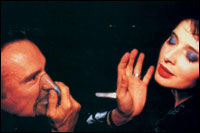Hollywood
Freaks
| |
 |
|
|
From terrifying male sadists in Blue
Velvet to mad mothers in Wild At Heart (1990),
grotesque and aberrant humans populate David Lynch’s work.
In Wild At Heart, Sailor and Lula meet the accidental,
bizarre, deviant and terrifying in their flight from Lula’s
mad mother. In Blue Velvet, the young hero Jeffrey
encounters a world graced by a mysterious, masochistic film-noir
beauty held hostage by a sadistic psychopath. Adhering to
his surreal and Felliniesque vision, Lynch’s corrupt Hollywood
is haunted by equally strange surreal and mythic characters.
Of course, the signature Lynchian figure of the dwarf - played
by Michael Anderson - makes an appearance as an all-powerful
and omniscient Mafioso mogul. But one of the more dominant,
bizarre figures in Mulholland Drive is The Cowboy,
a sinister, surreal-talking, waxen messenger of the powers
that be who cryptically warns Adam to make the right choice
of actress. Their meeting on Beachwood Canyon is both silly
and portentous. The cowboy tells Adam he will see him “one
time if you do good, twice if you do bad”. The older female
Hollywood citizen and actress personifies high camp and evoke
the myths and manners of a bygone Hollywood. Betty’s aunt’s
ivy-laden apartment complex on Havenhurst is presided over
by the singular Coco Lenoix in all-black and pearls who amusingly
complains about prize-fighting kangaroos on the premises while
engaging with Betty in an affable but patrician manner. With
her “Thank you, dahling”, Betty indeed mocks Coco’s
exaggerated manner - and the manners of old Hollywood characters
and stars such as Norma Desmond and Bette Davis - after practising
her lines with Rita. Perhaps, the performing character of
Coco also potentially anticipates Betty in the future. Betty’s
aunt we know is also an actress and with her endless role-playing,
she unceasingly aspires to the Hollywood game. Coco’s apartment
block is also home to another bizarre older woman, the apparently
insane, all-seeing hooded neighbour, Louise Bonner played
by striking sixties/seventies actress Lee Grant. Louise has
a surreal, lion-like face or, alternatively Hollywood, has
had some bizarre plastic surgery. When told Betty is an actress,
she inspects the younger woman with outlandish arrogance and
suspicion. On spying Rita, she warns all who will listen to
her : “Someone is in trouble...Something bad is happening...”
Thus, in Mulholland Drive, Lynch sustains a surrealist
fascination with the fantastic. The most horrific creature,
however, in Lynch’s Hollywood, is the monstrous tramp whom
we meet early in the primary narrative of Diane’s dream. We
see a terrified, seemingly neurotic younger man in a diner
- namely Winkies on Sunset Boulevard - talking to a middle-aged
man (his psychiatrist or film industry colleague ?) about
the dream he had of the same restaurant and an awful figure
who haunts the place and inspires the greatest kind of fear.
He confides : “There’s a man at the back of this place.
He’s the one who’s doing it...I hope I never see this face
ever outside of a dream”. We then see the men go to the
back of the diner. Like an anxiety dream, a nightmare instantly
conjured, the young man is confronted by the “man”. “He” is
filthy and covered with rags. “His” hair is matted and “his”
face is scarred. Apparently a homeless “man”, “he” is half-human
and has the eyes and face of a witch. The young man faints
at the shock. Who is this mysterious, monstrous figure at
the back of the diner ? Does “he” exist ? Perhaps
only the mad can see “him”. What is clear is that he is a
potent presence. Firstly, as the figure of a dream, he symbolises
a demon of the unconscious. “He” is, however, not only a figure
of one man’s nightmares but seems to represent the collective
unconscious of Hollywood. This extraordinary figure is bred
by Hollywood’s dehumanising powers. “He” is the wretched debris
produced and discarded by the city of angels. The mutating,
half-human is an horrific, dystopian figure. I argue that
this freakish hallucinatory image is the blackest image of
Mulholland Drive and most powerfully embodies Lynch’s
surreal and satiric powers as well as his humanity.
|